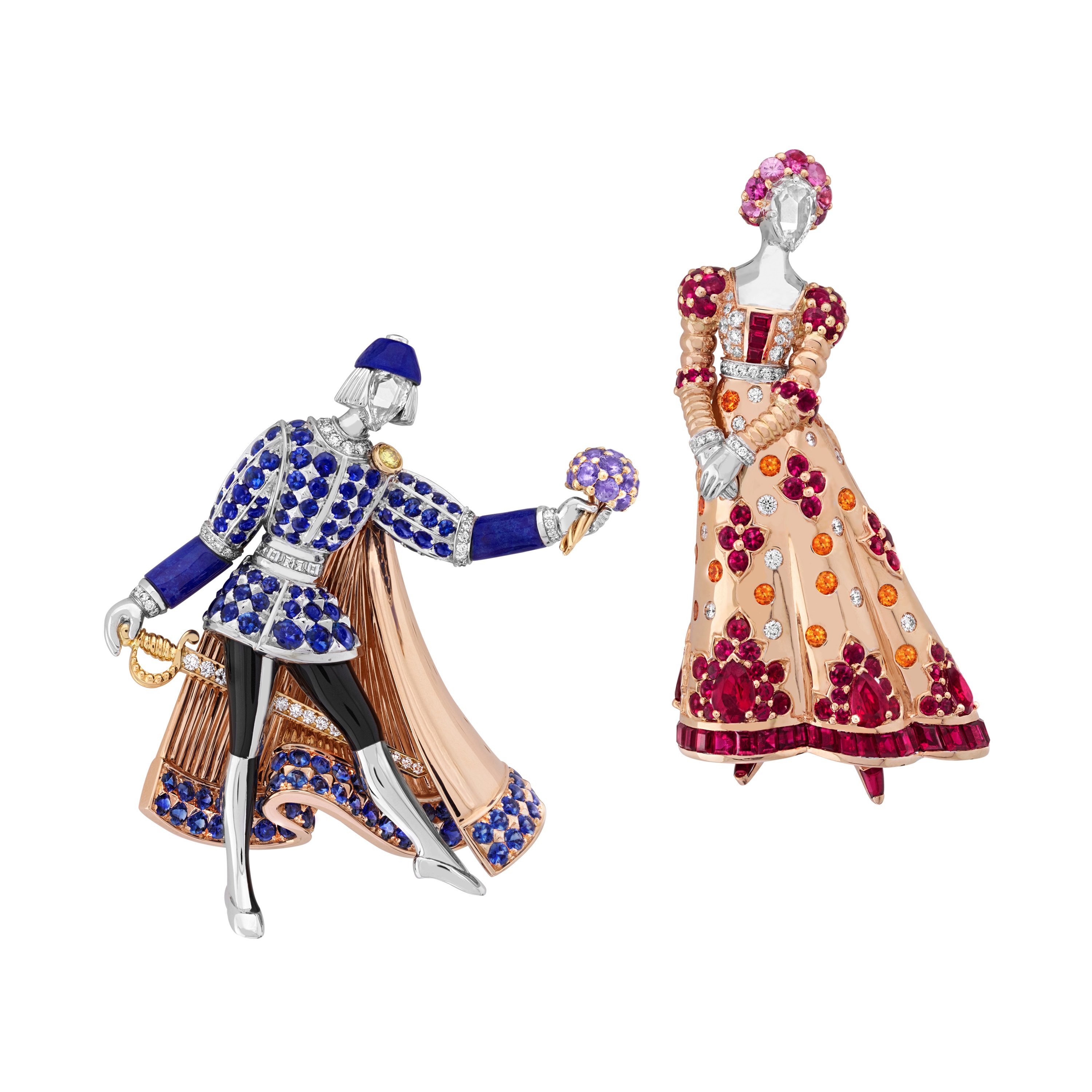
In 1967, a chance meeting between the jeweler Claude Arpels and the Russian choreographer George Balanchine inspired a ballet called Jewels.
This year, Van Cleef & Arpels returned the favor, in a way, by creating a high jewelry collection inspired by another ballet—in this case, Romeo and Juliet, directed by the acclaimed Los Angeles-based French choreographer and dancer Benjamin Millepied.
Both the collection and the ballet take their initial inspiration from William Shakespeare’s romantic tragedy. Van Cleef and Arpels’s jewelry version was recently unveiled in Paris, while Millepied’s production—which mixes film with live stage performances—will premiere next spring.
“With this collection, we wanted to explore the universe of dance as a tribute to our history with 20th-century dance going back to Balanchine, and to inscribe ourselves in a contemporary production with Benjamin Millepied,” Van Cleef & Arpels President and CEO Nicolas Bos said at the launch of the Romeo and Juliet collection.
The Night or Day brooch from the Romeo and Juliet collection. Courtesy of Van Cleef & Arpels.
The added depth that culture can lend to luxury has long been part of the vision that Bos, who started his own career at the Fondation Cartier pour l’Art Contemporain, has brought to Van Cleef & Arpels. “We have great admiration for art and artists, and believe that working with talents in creative fields different from our own can be a very enriching adventure,” Bos said. “Before we produce the first drawing of any thematic collection, we look at how others—artists or choreographers—have interpreted the same theme.”
Van Cleef & Arpels’s love affair with dance goes back to its ballerina brooches of the 1940s, predating Balanchine’s famous ballet, which unfolded across three acts entitled “Emeralds,” “Rubies,” and “Diamonds.” So it comes as no surprise that the jeweler has been supporting Millepied’s Los Angeles Dance Project company since 2012, first helping him to produce a dance trilogy called Gems.
As a result, when Bos heard that Millepied wanted to produce a ballet inspired by Romeo and Juliet, it seemed like a natural continuation. “It struck me as a creative opportunity for Van Cleef,” the CEO said. “We realized that other creative minds were looking at the same theme.”
The Collier Reticella necklace. Courtesy of Van Cleef & Arpels.
As it happens, the theme of love is also well-trodden terrain for Van Cleef & Arpels, whose most memorable pieces have been associated with famous romances. Just think of the spectacular ruby-and-diamond necklace that the Duke of Windsor, then King Edward VIII, commissioned as a gift for Wallis Simpson before renouncing the throne of England, or the pearl-and-diamond set made for Grace Kelly when she married Prince Rainier of Monaco.
The jeweler has explored the Shakespearean repertoire before as well, with a delicately feminine 2003 collection called A Midsummer Night’s Dream that was replete with fairies, butterflies, birds in flight, and flowers swaying in the wind.
This time, it was love Italian-style that Van Cleef & Arpels chose as a central premise for the 100 one-of-a-kind pieces in the Romeo and Juliet collection, while remaining faithful to the historical context in which Shakespeare set his play: Renaissance-era Verona, seen as the backdrop of an ancient family feud between the Montagues and Capulets. “We wanted to tell this story with figurative pieces that represent the lovers and the balcony,” said Bos, “but also with abstract ones to evoke the ambiance and architecture of Verona.”
A drawing of Romeo and Juliet by Lorenzo Mattotti. Courtesy of Van Cleef & Arpels.
The stage for Van Cleef & Arpels’s version of Romeo and Juliet was set under the glass-domed courtyard of the Hôtel d’Évreux—off of the Place Vendôme—which was transformed into a luxuriant Italian garden filled with olive trees and blooming bougainvillea. Its walls were lined with long panels of watercolors by the Italian artist Lorenzo Mattotti, stretched floor-to-ceiling in shades of red, orange, and violet to trace the contours of the Verona palazzo where Romeo serenaded Juliet.
Music from Sergei Prokofiev’s 1935 ballet Romeo and Juliet, meanwhile, further brought the scene to life, as a video projection in the background showed intertwined dancers rehearsing passages from Millepied’s production.
The Balcone brooch. Courtesy of Van Cleef & Arpels.
Van Cleef & Arpels’s collection reenacted the play’s drama through the art of high jewelry, as with the charming Balcone brooch that, dripping with emeralds and garnets, recalled the balcony where Romeo and Juliet declared their love. Likewise, a bracelet representing the castellated ramparts of Verona was mystery-set with rubies—using a technique perfected by Van Cleef & Arpels in the 1930s—to evoke architectural details of the medieval city. A pair of brooches representing the two lovers brought back the grace of the jeweler’s signature ballerinas while showing an evolution from another pair of Romeo and Juliet clips made in 1951, confirming Van Cleef & Arpels’s long tradition of three-dimensional figurative craftsmanship.
The Matrimonio necklace. Courtesy of Van Cleef & Arpels.
As for the abstract pieces, they “establish a more subtle link with the story,” explained Bos. Borrowing from the coat of arms of the two families, blue sapphires and lapis lazuli evoke the world of Romeo, while red spinels, orange sapphires, garnets, and rubies represent the universe of Juliet. The couple’s love and brief marriage are conjured through shades of violet in the graduated setting of blue, purple, and pink stones, blending together in the Inamorato bracelet and the Matrimonio necklace.
The Lovers’ Path bracelet. Courtesy of Van Cleef & Arpels.
Their happiness, as we know, was not to last. Colombian emeralds set on the Lovers’ Path bracelet hint at hope—but their “forked” path setting, glinting with diamonds, suggests the couple’s tragic destiny.
Today, however, their love lives on, with their story celebrated in this extraordinary collection’s marriage of fine craftsmanship and culture, bringing together literature, jewelry, and dance.